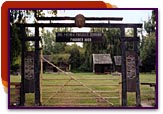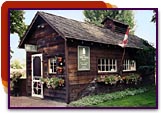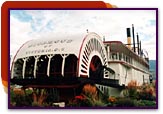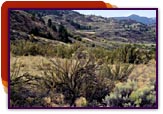|
|
 |
Heritage Attractions
Father Pandosy Mission
Pioneer settlement in the Kelowna area began in 1860 when Father Pandosy pre-empted land on the banks of L'Anse au Sable (Mission Creek). This area was ideal for pioneers - there was ample timber for houses, barns and fences, open parkland vegetation for grazing livestock, and sufficient water in the valley's major creeks. The District's economy revolved largely around cattle ranching and grain growing in the latter half of the last century. In the 1890's, commercial fruit growing was attempted, bringing many new settlers to the area. pre-empted land on the banks of L'Anse au Sable (Mission Creek). This area was ideal for pioneers - there was ample timber for houses, barns and fences, open parkland vegetation for grazing livestock, and sufficient water in the valley's major creeks. The District's economy revolved largely around cattle ranching and grain growing in the latter half of the last century. In the 1890's, commercial fruit growing was attempted, bringing many new settlers to the area.
Visit their Website at http://www.welcometokelowna.com/parks/fatherpandosy
|
Guisachan Heritage Park
Guisachan Heritage Park is a site of considerable historical, heritage and horticultural interest. The present 2.4 acres are situated at the centre of what was one of Kelowna's earliest ranches, pre-empted by John McDougall in 1861.
 The Earl and Countess of Aberdeen purchased the ranch in 1890 and established the first large-scale planting of fruit trees and hops in the Central Okanagan. Lord Aberdeen, later Governor General of Canada, and Lady Aberdeen, founder of the World Council of Women and the Victorian Order of Nurses, named Guisachan after an estate of Lady Aberdeen's father in Invernessshire, Scotland. The Earl and Countess of Aberdeen purchased the ranch in 1890 and established the first large-scale planting of fruit trees and hops in the Central Okanagan. Lord Aberdeen, later Governor General of Canada, and Lady Aberdeen, founder of the World Council of Women and the Victorian Order of Nurses, named Guisachan after an estate of Lady Aberdeen's father in Invernessshire, Scotland.
In 1891, Guisachan House was built for the Aberdeens in Indian colonial bungalow style.
The Cameron family bought the property in 1903 and lived there for eighty-one years. Paddy Cameron operated a dairy farm for many years and was noted for his love of horses. Many paper chases and gymkhanas were held at Guisachan.
The renowned Edwardian gardens were the work of Elain Cameron, whose detailed diaries made the restorations possible. Mrs. Cameron, an accomplished pianist, taught several generations of Kelowna children. Guisachan ranch was an integral part of Kelowna's social and cultural life for many years.
Visit their Website at http://www.welcometokelowna.com/parks/guisachan.htm
|
SS Sicamous
The S.S Sicamous, the largest remaining steel-led sternwheeler in Canada, is located on the southern shores of Lake Okanagan in Penticton, British Columbia. Built in 1914 at Okanagan Landing for Canadian Pacific Railway and British Columbia Lake and River Service, it plied the waters of Okanagan Lake until 1936, from her Penticton homeport. It was the epitome of luxury and utility as it had exceptional passenger, mail and freight service.
 The history of steam navigation on BC's lakes and rivers has many facets and marked a period of enormous changes in the way people lived, worked, traveled and homesteaded. The S.S. Sicamous was the largest and most beautiful of the sternwheelers that helped shape the lives of people in the Okanagan Valley of British Columbia. Its role was played from 1914 to 1936. The history of steam navigation on BC's lakes and rivers has many facets and marked a period of enormous changes in the way people lived, worked, traveled and homesteaded. The S.S. Sicamous was the largest and most beautiful of the sternwheelers that helped shape the lives of people in the Okanagan Valley of British Columbia. Its role was played from 1914 to 1936.
It was a multi-purpose vessel designed to combine elaborate first class passenger accommodations with a large cargo capacity and daily mail service. The shallow-draught hull and stern wheel propulsion permitted beach landings, resulting in less extensive wharves being required and the advent of service to small communities.
The Sicamous was operational for 23 years. In its 22nd year it was deconstructed/reconstructed by removing its Texas Deck, two-thirds of it Gallery Deck (3rd deck) and lowering its deckhead onto the Dining Room/Stern Saloon (2nd Deck).
Visit their Website at http://www.sssicamous.com
|
The Desert Centre
Tucked into the southernmost corner of British Columbia's beautiful Okanagan Valley, this extraordinary habitat is home to one of North America's most fragile and endangered ecosystems. The area hosts one of the largest concentrations of species at risk (over 100 rare plants and over 300 rare invertebrates) in Canada and is of international importance.
 The Desert Centre is an interpretive education and research facility offering insight into this sensitive ecosystem, its plants and animals. You can take a fascinating excursion along the elevated boardwalk and experience the intimate beauty of our special desert. The Desert Centre is an interpretive education and research facility offering insight into this sensitive ecosystem, its plants and animals. You can take a fascinating excursion along the elevated boardwalk and experience the intimate beauty of our special desert.
The Osoyoos Desert Centre is an ecological interpretive centre on a protected portion of this habitat and has a carefully placed boardwalk around the area where visitors can learn about desert ecology, ecological restoration, and conservation of endangered ecosystems in the South Okanagan.
Visit their Website at http://www.desert.org
|
The Grist Mill
When Barrington Price built his flour mill in 1877, he probably never imagined it would be operating again in the 1990s! In his time, it was equipped with some of the best milling equipment available, including a James Jones roller mill and a Barford & Perkins grinder. It was state-of-the-art technology in the 1880s, and now it's the last example of a pioneer B.C. mill that still has its historic, original machinery and building in place!
 It has taken years of painstaking research to re-assemble and restore the operating layout to its 1881 configuration. When the restoration of the mill began in the 1980s, the old machines and parts were found in a jumble on the lower level -- with Price's Eureka Grain Cleaner actually holding up the sagging second floor! Careful analysis of every nail hole and wear mark inside the building has enabled the original position of each machine and pulley frame to be identified or calculated. During your visit, you'll find out about this intricate detective work, and what archaeologists have discovered about the history of the mill! It has taken years of painstaking research to re-assemble and restore the operating layout to its 1881 configuration. When the restoration of the mill began in the 1980s, the old machines and parts were found in a jumble on the lower level -- with Price's Eureka Grain Cleaner actually holding up the sagging second floor! Careful analysis of every nail hole and wear mark inside the building has enabled the original position of each machine and pulley frame to be identified or calculated. During your visit, you'll find out about this intricate detective work, and what archaeologists have discovered about the history of the mill!
Now a working waterwheel and flume provide power to the inner workings of the mill. In Price's old store, now a museum of unique hands-on exhibits, you'll be able to operate various devices that demonstrate the principles involved in 19th-century flour milling.
The sunny Similkameen area of southern British Columbia's interior, close to the Canadian and United States border, is famous for the quality of products from its orchard industry. The Grist Mill has an heirloom apple orchard, a Living Museum of Wheat growing on the upper fields, and some of the most interesting organically-managed heritage gardens in Canada!
Visit their Website at http://www.heritage.gov.bc.ca/grist/grist.htm
|
|
|
|
 |